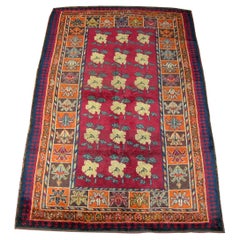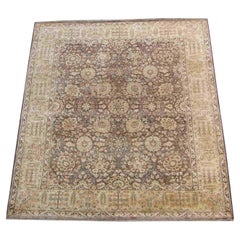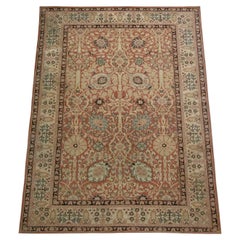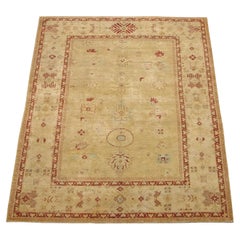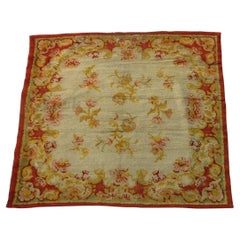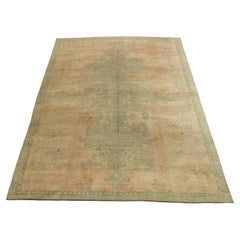Y & B Bolour
to
183
464
416
324
323
293
161
106
104
103
65
60
54
51
32
28
28
22
18
12
11
9
9
7
6
5
4
2
2
2
2
2
2
2
1
1
1
1
1
1
1
1
1
1
19th Century Persian Tribal Gabbeh Rug
Located in Los Angeles, US
Persian Gabbeh Rugs – Persian rugs made with extra high pile and very simple, graphic designs focused on the use of color, which can be vibrant or soft and earthy. As pieces made for...
Category
Antique Early 1900s Tribal Russian and Scandinavian Rugs
Materials
Wool
Handmade Pakistani Lahore Rug 9'11" X 7'11"
Located in Los Angeles, US
Vintage Handmade Pakistani Lahore Rug 9'11" X 7'11"
Category
Early 2000s Pakistani Tabriz Turkish Rugs
Materials
Wool, Cotton
Pakistani Lahore Tabriz Design Rug 8'10" X 6'0"
Located in Los Angeles, US
Vintage Pakistani Lahore Tabriz Design Rug 8'10" X 6'0"
Category
Early 2000s Pakistani Tabriz Turkish Rugs
Materials
Wool, Cotton
Handmade Pakistani Lahore Rug 11'6" X 9'0"
Located in Los Angeles, US
Handmade Vintage Pakistani Lahore Rug 11'6" X 9'0"
Category
Early 2000s Pakistani Other Turkish Rugs
Materials
Wool, Cotton
Mid-19th Century English Woolen Rug 5'6'' X 5'5''
Located in Los Angeles, US
Mid-19th Century English Woolen Rug 5'6'' x 5'5'', Made in England (UK) in mid 19th century and has been passed around generations and it has a royalty fam...
Category
Antique Early 1900s Other Russian and Scandinavian Rugs
Materials
Wool
19th Century Tribal Turkish Rug 13'6" X 9'8"
Located in Los Angeles, US
Antique Turkish Oushak rugs have been woven in Western Turkey since the beginning of the Ottoman period. Historians attributed to them many of the great masterpieces of early Turkish...
Category
Antique 19th Century Turkish Oushak Turkish Rugs
Materials
Wool, Cotton
Vintage Handmade Lahore Rug 9'9" X 8'0"
Located in Los Angeles, US
Antique Turkish Oushak rugs have been woven in Western Turkey since the beginning of the Ottoman period. Historians attributed to them many of the great masterpieces of early Turkish...
Category
Early 2000s Turkish Oushak Turkish Rugs
Materials
Wool, Cotton
Late-19th Century Spanish Woolen Rug
Located in Los Angeles, US
Late-19th Century Spanish Woolen Rug 6'3'' x 4'10", made in Spain around late 19th century by villagers at the time
Category
Vintage 1920s Empire Russian and Scandinavian Rugs
Materials
Wool
19th Century Tribal Caucasian Rug
Located in Los Angeles, US
The antique Caucasian rugs get their name from the area in which they were made – the Caucasus. The Caucasus is a region that produces distinctive rugs since the end of the 18th cent...
Category
Antique 19th Century Other Russian and Scandinavian Rugs
Materials
Wool
19th Century European Portuguese Rug
Located in Los Angeles, US
When many people think of carpets, what comes to mind are the pile rugs and traditional kilims of the middle east. Kilims are similar to a tapestry weaving and have a flat weave, as ...
Category
Antique 19th Century Other Russian and Scandinavian Rugs
Materials
Wool
19th Century European Portuguese Rug
Located in Los Angeles, US
When many people think of carpets, what comes to mind are the pile rugs and traditional kilims of the middle east. Kilims are similar to a tapestry weaving and have a flat weave, as ...
Category
Antique 19th Century Other Russian and Scandinavian Rugs
Materials
Wool
Mid-19th Century European Aubusson Style Rug
Located in Los Angeles, US
Mid-19th Century European Aubusson Style Rug 5'7'' x 4'5'' , handmade and hand-knotted, empire traditional style
Category
Antique 19th Century Empire Russian and Scandinavian Rugs
Materials
Wool
Mid-19th Century Persian Zanjan Rug 5.6x4.1
Located in Los Angeles, US
Antique Zanjan Rug 5.6x4.1, handmade and hand-knotted, wool on cotton foundation, tribal carpet, authentic Persian carpet, vegetable dyes, tribal carpet from mid-19th Century
Category
Antique Early 1900s Other Russian and Scandinavian Rugs
Materials
Wool, Cotton
Antique Turkish Prayer Rug 4.6x3.3
Located in Los Angeles, US
Antique TURKISH PRAYER Rug 4.6X3.3, handmade and hand-knotted, tribal and unique pieces,
woolen carpet, authentic Turkish carpe
Category
Antique Early 1900s Other Turkish Rugs
Materials
Wool, Cotton
Antique Indian Rug 7.1x5.8
Located in Los Angeles, US
Antique Indian Rug 7'1" X5'8" handmade and hand-knotted, wool on cotton foundation with floral design, authentic indian carpet
Category
Antique Early 1900s Other Indian Rugs
Materials
Wool, Cotton
Antique Malayer Rug 6.6x4.2
Located in Los Angeles, US
Antique MALAYER Rug 6.6x4.2, handmade and hand-knotted, tribal carpet, authentic Persian woolen carpet
Category
Antique Early 1900s Other Russian and Scandinavian Rugs
Materials
Wool, Cotton
Antique Malayer Rug 4.9 X 3.5
Located in Los Angeles, US
Antique Malayer Rug 4.9 X 3.5 , handmade and hand-knotted, tribal rug , Wool on cotton foundation, authentic Persian Carpet
Category
Antique Early 1900s Tribal Russian and Scandinavian Rugs
Materials
Wool, Cotton
Antique Gabeh Rug 6.2x4.0
Located in Los Angeles, US
Antique Gabeh Rug 6.2x4.0, handmade and hand-knotted,
Category
Antique Early 1900s Other Russian and Scandinavian Rugs
Materials
Wool, Cotton
Antique Portuguese Rug 8.4x4.0
Located in Los Angeles, US
Antique PORTUGUESE Rug 8.4X4.0, handmade , traditional European style
Category
Vintage 1910s Other Russian and Scandinavian Rugs
Materials
Wool, Cotton
19th Century Shirvan Rug 6'5" X 4'0"
Located in Los Angeles, US
19th Century Shirvan Rug 6'5" X 4'0", handmade and hand-knotted
Category
Early 2000s Other Russian and Scandinavian Rugs
Materials
Wool, Cotton
Antique 19th Century Samarkand Rug
Located in Los Angeles, US
Antique Samarkand Rugs: The desert oasis of Khotan was an important stop on the Silk Road. The people of Khotan were expert carpet weavers who produced high quality antique rugs and ...
Category
Antique Early 1900s Other Russian and Scandinavian Rugs
Materials
Wool, Cotton
Mid-19th Century Indian Amritzar Rug
Located in Los Angeles, US
Antique Amritsar Rugs – The spectacular rugs of Amritsar capture the exotic style of India while incorporating a subtle colonial influence. This convergence of eastern and western st...
Category
Antique Early 1900s Empire Indian Rugs
Materials
Wool, Cotton
Antique Samarkand Rugs: The desert oasis of Khotan was an important stop on the
Located in Los Angeles, US
Antique Samarkand Rugs: The desert oasis of Khotan was an important stop on the Silk Road. The people of Khotan were expert carpet weavers who produced high quality antique rugs and ...
Category
Vintage 1920s Other Russian and Scandinavian Rugs
Materials
Wool, Cotton
1920s Antique Samarkand Rug
Located in Los Angeles, US
Antique Samarkand Rugs: The desert oasis of Khotan was an important stop on the Silk Road. The people of Khotan were expert carpet weavers who produced high quality antique rugs and ...
Category
Vintage 1920s Other Russian and Scandinavian Rugs
Materials
Wool, Cotton
1920s Antique Samarkand Rug
Located in Los Angeles, US
Antique Samarkand Rugs: The desert oasis of Khotan was an important stop on the Silk Road. The people of Khotan were expert carpet weavers who produced high quality antique rugs and ...
Category
Vintage 1920s Other Russian and Scandinavian Rugs
Materials
Wool, Cotton
Antique 1920 Samarkand Rug
Located in Los Angeles, US
Antique Samarkand Rugs: The desert oasis of Khotan was an important stop on the Silk Road. The people of Khotan were expert carpet weavers who produced high quality antique rugs and ...
Category
Antique Early 1900s Other Russian and Scandinavian Rugs
Materials
Wool, Cotton
Antique 1900 Samarkand Rug
Located in Los Angeles, US
Antique Samarkand Rugs: The desert oasis of Khotan was an important stop on the Silk Road. The people of Khotan were expert carpet weavers who produced high quality antique rugs and ...
Category
Antique Early 1900s Other Russian and Scandinavian Rugs
Materials
Wool, Cotton
19th Century Turkish Oushak Rug 13'9" X 10'10"
Located in Los Angeles, US
Antique Turkish Oushak rugs have been woven in Western Turkey since the beginning of the Ottoman period. Historians attributed to them many of the great masterpieces of early Turkish...
Category
Antique 19th Century Turkish Oushak Turkish Rugs
Materials
Wool, Cotton
Antique 1920 Samarkand Rug
Located in Los Angeles, US
Antique Samarkand Rugs: The desert oasis of Khotan was an important stop on the Silk Road. The people of Khotan were expert carpet weavers who produced high quality antique rugs and ...
Category
Vintage 1920s Other Russian and Scandinavian Rugs
Materials
Wool, Cotton
19th Century Tribal Turkish Oushak Rug 15'2" X 10'0"
Located in Los Angeles, US
Antique Turkish Oushak rugs have been woven in Western Turkey since the beginning of the Ottoman period. Historians attributed to them many of the great masterpieces of early Turkish...
Category
Antique 19th Century Turkish Oushak Turkish Rugs
Materials
Wool, Cotton
Mid 19th Century Tribal Turkish Oushak Rug
Located in Los Angeles, US
Antique Turkish Oushak rugs have been woven in Western Turkey since the beginning of the Ottoman period. Historians attributed to them many of the great masterpieces of early Turkish...
Category
Antique Mid-19th Century Turkish Oushak Turkish Rugs
Materials
Wool, Cotton
Handmade Lahore Area Rug 10'6" X 7'2"
Located in Los Angeles, US
Vintage Handmade Pakistani Lahore Rug 10'6" x 7'2"
Category
Early 2000s Pakistani Other Turkish Rugs
Materials
Wool, Cotton
Early 19th Century 1850 Century Tribal Turkish Oushak Rug
Located in Los Angeles, US
Antique Turkish Oushak rugs have been woven in Western Turkey since the beginning of the Ottoman period. Historians attributed to them many of the great masterpieces of early Turkish...
Category
Antique Mid-19th Century Turkish Oushak Turkish Rugs
Materials
Wool, Cotton
Mid 19th Century Turkish Oushak Rug
Located in Los Angeles, US
The history of Turkish rugs and weavings is as complex as it is ancient. The production of fine rugs and carpets is a practice that dates back millennia. In certain societies and cul...
Category
Antique Mid-19th Century Turkish Oushak Turkish Rugs
Materials
Wool, Cotton
Mid 19th Century Tribal Turkish Oushak Rug
Located in Los Angeles, US
Antique Turkish Oushak rugs have been woven in Western Turkey since the beginning of the Ottoman period. Historians attributed to them many of the great masterpieces of early Turkish...
Category
Antique Mid-19th Century Turkish Oushak Turkish Rugs
Materials
Wool, Cotton
Early 20th Century Antique Turkish Oushak Rug
Located in Los Angeles, US
Antique Turkish Oushak rugs have been woven in Western Turkey since the beginning of the Ottoman period. Historians attributed to them many of the great masterpieces of early Turkish...
Category
Early 20th Century Turkish Oushak Turkish Rugs
Materials
Wool, Cotton
Early 20th Century Antique Oushak Rug
Located in Los Angeles, US
Antique Turkish Oushak rugs have been woven in Western Turkey since the beginning of the Ottoman period. Historians attributed to them many of the great masterpieces of early Turkish...
Category
Early 20th Century Turkish Oushak Turkish Rugs
Materials
Wool, Cotton
Early 20th Century Antique Indian Rug
Located in Los Angeles, US
Traditionally, the Indian rugs are some of the most desirable rugs amongst collectors and interior designers. India is known for their production of fine Indian textiles, palace size...
Category
Early 20th Century Indian Other Indian Rugs
Materials
Wool, Cotton
1900 Antique Turkish Oushak
Located in Los Angeles, US
The Oushak rugs have become the rugs of choice for many of the top interior decorators in the world today. Just open any copy of architectural digest and you will see these magnifice...
Category
Antique Early 1900s Turkish Oushak Turkish Rugs
Materials
Wool, Cotton
$17,249
Antique Kurdi Tribe Rug
Located in Los Angeles, US
Kurdish rugs are as diverse as the ethnic weavers who created them. The presence of Kurdish weavers in the northwestern area of Persia and the Iranian Kurd...
Category
Antique Early 1900s Other Russian and Scandinavian Rugs
Materials
Wool, Cotton
$3,900
1940s Vintage Tabriz Rug
Located in Los Angeles, US
Located in the far northwest of Persia, Tabriz has been a leading center for the production of the finest rugs and carpets since the fourteenth century if not earlier. By 1500 it had...
Category
Vintage 1940s Other Russian and Scandinavian Rugs
Materials
Wool, Cotton
$9,998
Antique 1920 Spanish Rug
Located in Los Angeles, US
Spanish Rugs – Although Spain is not generally thought of as a rug producing region, Spanish rugs represent the most venerable and honored tradition of rug production in Europe, goin...
Category
Vintage 1920s Other Russian and Scandinavian Rugs
Materials
Wool, Cotton
$9,300
Antique 1920 Samarkand Rug
Located in Los Angeles, US
Antique Samarkand Rugs: The desert oasis of Khotan was an important stop on the Silk Road. The people of Khotan were expert carpet weavers who produced high quality antique rugs and ...
Category
Vintage 1920s Other Russian and Scandinavian Rugs
Materials
Wool, Cotton
Antique Geometric Shirvan Rug
Located in Los Angeles, US
Shirvan rugs – The historic Khanate or administrative district of Shirvan produced many highly decorative antique rugs that have a formality and stylistic complexity that is found in...
Category
Antique Early 1900s Other Russian and Scandinavian Rugs
Materials
Wool, Cotton
Antique 1920 Indian Rug
Located in Los Angeles, US
Traditionally, the Indian rugs are some of the most desirable rugs amongst collectors and interior designers. India is known for their production of fine Indian textiles, palace size...
Category
Vintage 1920s Indian Other Indian Rugs
Materials
Wool, Cotton
$14,250
Antique 1920 Indian Rug
Located in Los Angeles, US
Traditionally, the Indian rugs are some of the most desirable rugs amongst collectors and interior designers. India is known for their production of fine Indian textiles, palace size...
Category
Vintage 1920s Indian Other Indian Rugs
Materials
Wool, Cotton
$27,000
Antique 19th Century Samarkand Rug
Located in Los Angeles, US
Antique Samarkand Rugs: The desert oasis of Khotan was an important stop on the Silk Road. The people of Khotan were expert carpet weavers who produced high quality antique rugs and ...
Category
Antique 19th Century Uzbek Other Russian and Scandinavian Rugs
Materials
Wool, Cotton
Antique 19th Century Samarkand Rug
Located in Los Angeles, US
Antique Samarkand Rugs: The desert oasis of Khotan was an important stop on the Silk Road. The people of Khotan were expert carpet weavers who produced high quality antique rugs and ...
Category
Antique 19th Century Uzbek Other Russian and Scandinavian Rugs
Materials
Wool, Cotton
Mid 19th Century Antique Samarkand Rug
Located in Los Angeles, US
Antique Samarkand Rugs: The desert oasis of Khotan was an important stop on the Silk Road. The people of Khotan were expert carpet weavers who produced high quality antique rugs and ...
Category
Antique Mid-19th Century Uzbek Other Russian and Scandinavian Rugs
Materials
Wool, Cotton
Antique 1900 Samarkand Rug
Located in Los Angeles, US
Antique Samarkand Rugs: The desert oasis of Khotan was an important stop on the Silk Road. The people of Khotan were expert carpet weavers who produced high quality antique rugs and ...
Category
Antique Early 1900s Other Russian and Scandinavian Rugs
Materials
Wool, Cotton
Antique 1920 Floral Samarakand Rug
Located in Los Angeles, US
Antique Samarkand Rugs: The desert oasis of Khotan was an important stop on the Silk Road. The people of Khotan were expert carpet weavers who produced high quality antique rugs and ...
Category
Vintage 1920s Other Russian and Scandinavian Rugs
Materials
Wool, Cotton
Antique 1920 Floral Samarkand Rug
Located in Los Angeles, US
Antique Samarkand Rugs: The desert oasis of Khotan was an important stop on the Silk Road. The people of Khotan were expert carpet weavers who produced high quality antique rugs and ...
Category
Vintage 1920s Other Russian and Scandinavian Rugs
Materials
Wool, Cotton
Antique 1920 Floral Samarkand Rug
Located in Los Angeles, US
Antique Samarkand Rugs: The desert oasis of Khotan was an important stop on the Silk Road. The people of Khotan were expert carpet weavers who produced high quality antique rugs and ...
Category
Vintage 1920s Other Russian and Scandinavian Rugs
Materials
Wool, Cotton
Late-19th Century Persian Heriz Serapi Carpet
Located in Los Angeles, US
Antique Heriz Carpets Serapi Rugs and Persian Bakshaish Carpets – The carpets of northwest Persia are in a class of their own. Prized for their strong geometric style, fine construct...
Category
Antique 1880s Persian Tabriz Persian Rugs
Materials
Wool, Cotton
Early 20th Century Vintage Flat Weave Shahsavand Kilim Rug
Located in Los Angeles, US
Antique rugs that are called “Kilim rugs”, primarily refer to a type of flat weave rug that was produced without knotted pile. Because these antique rugs are found across the globe, ...
Category
Antique Early 1900s Other Russian and Scandinavian Rugs
Materials
Wool, Cotton
Early 20th Century Antique Traditional Flat Weave Bessarabian Rug
Located in Los Angeles, US
Antique Bessarabian Rugs / Kilims in both pile and tapestry weaving technique are some of the more beautiful carpets to have been produced in Europe. Many of the Bessarabian Kilims w...
Category
Antique Early 1900s Other Russian and Scandinavian Rugs
Materials
Wool, Cotton
Late 19th Century Bessarabian Kilim Rug
Located in Los Angeles, US
Antique rugs that are called “Kilim rugs”, primarily refer to a type of flat weave rug that was produced without knotted pile. Because these antique rugs are found across the globe, ...
Category
Antique 19th Century Other Russian and Scandinavian Rugs
Materials
Wool, Cotton
1900 Fine Antique Chinese Rug
Located in Los Angeles, US
Antique Chinese Rugs, as opposed to most of the antique rug productions, were woven almost exclusively for internal consumption. Since they were mostly sheltered from European and We...
Category
Antique Early 1900s Other Russian and Scandinavian Rugs
Materials
Wool, Cotton
19th Century Antique Bessarabian Floral Rug
Located in Los Angeles, US
ntique Bessarabian Rugs / Kilims in both pile and tapestry weaving technique are some of the more beautiful carpets to have been produced in Europe. Many of the Bessarabian Kilims we...
Category
Antique Early 1900s Other Russian and Scandinavian Rugs
Materials
Wool, Cotton
Antique Bessarabian Floral Rug
Located in Los Angeles, US
Antique Bessarabian Rugs / Kilims in both pile and tapestry weaving technique are some of the more beautiful carpets to have been produced in Europe. Many of the Bessarabian Kilims w...
Category
Antique Early 1900s Other Russian and Scandinavian Rugs
Materials
Wool, Cotton
